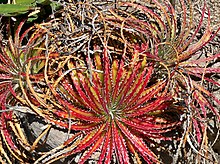
Agave americana, common names sentry plant, century plant, maguey or American aloe, is a species of flowering plant in the family Asparagaceae, native to Mexico and the United States in Texas. Today, it is cultivated worldwide as an ornamental plant. It has become naturalized in many regions, including the West Indies, parts of South America, the southern Mediterranean Basin, and parts of Africa, India, China, Thailand, and Australia.

Allium canadense, the Canada onion, Canadian garlic, wild garlic, meadow garlic and wild onion is a perennial plant native to eastern North America from Texas to Florida to New Brunswick to Montana. The species is also cultivated in other regions as an ornamental and as a garden culinary herb. The plant is also reportedly naturalized in Cuba.
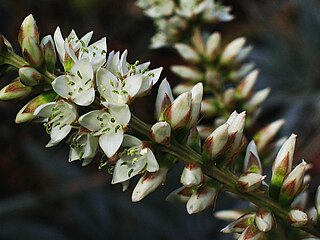
Hechtia is a genus of plants in the family Bromeliaceae, and is the sole genus of the subfamily Hechtioideae, containing 75 species. Its species are native to Mexico, Central America, and Texas.

Agave lechuguilla is an Agave species found only in the Chihuahuan Desert, where it is an indicator species. It typically grows on calcareous soils. The plant flowers once in its life, then it dies. The flowers are a source of nutrients for insects, bats, and some birds.

Colubrina is a genus of about 30 species of flowering plants in the family Rhamnaceae, native to warm temperate to tropical regions of Africa, the Americas, southern Asia, northern Australia, and the Indian Ocean islands. Common names include nakedwood, snakewood, greenheart and hogplum. The generic name is derived from the Latin word coluber, meaning "snake", and refers to the snake-like stems or stamens.
Celosia palmeri, commonly known as Palmer's cockscomb, is a species of flowering plant in the amaranth family, Amaranthaceae, that is native to the lower Rio Grande Valley of Texas in the United States as well as northeastern Mexico. The specific name honours British botanist Edward Palmer (1829–1911), who collected the type specimen in Monclova Municipality, Coahuila in 1880. It is a perennial shrub reaching a height of 0.3–1 m (0.98–3.28 ft). Flowering takes place from summer to winter.

Hesperaloe is a genus of flowering plants in the family Asparagaceae, subfamily Agavoideae. It contains perennial yucca-like plants with long, narrow leaves produced in a basal rosette and flowers borne on long panicles or racemes. The species are native to the arid parts of Texas in the United States and Mexico and are sometimes cultivated as xerophytic ornamental plants.
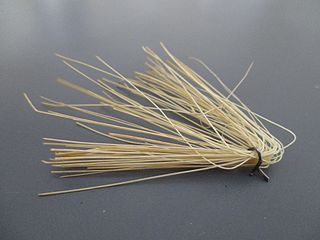
Ixtle, also known by the trade name Tampico fiber, is a stiff plant fiber obtained from a number of Mexican plants, chiefly species of Agave and Yucca. The principal source is Agave lechuguilla, the dominant Agave species in the Chihuahuan Desert. Ixtle is the common name of the plants producing the fiber. Ixtle is also the common name of a species of bromeliad, Aechmea magdalenae, grown in southern Mexico for its silky fibers.
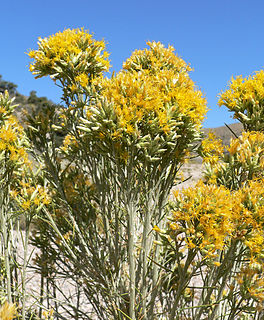
Lepidospartum is a genus of North American desert shrubs in the daisy family. They are known commonly as broomsages or scalebrooms. These are tall, woody shrubs with stiff twiggy branches that resemble brooms. They are native to the southwestern United States and far northern Mexico. These shrub have thin, narrow, needlelike or scalelike leaves and bear yellow daisy flowers.

Eatonella is a North American genus of plants in the daisy family containing the single known species Eatonella nivea, which is called by the common name white false tickhead. This small annual is native to the western United States, particularly the Great Basin, where it grows in sandy soils. It has been found in Washington, Oregon, Idaho, Nevada, and eastern California.
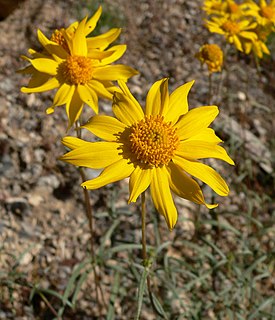
Heliomeris is a genus of flowering plants in the sunflower family known generally as false goldeneyes.
Arnica viscosa is an uncommon North American species of arnica in the sunflower family, known by the common name Mount Shasta arnica.
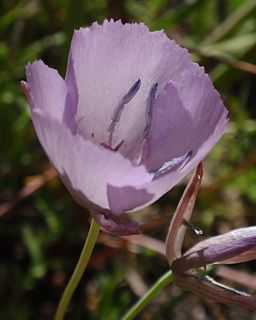
Calochortus nudus is a North American species of flowering plant in the lily family known by the common name naked mariposa lily.
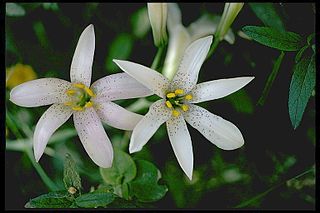
Lilium rubescens is an uncommon species of lily known by the common names redwood lily and chaparral lily. It is native to northwestern California and southwestern Oregon, where it is known from the Coast Ranges from Lane County to Santa Cruz Counties.
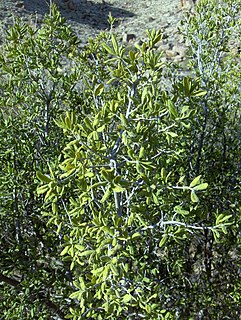
Diospyros texana is a species of persimmon that is native to central, south and west Texas and southwest Oklahoma in the United States, and eastern Chihuahua, Coahuila, Nuevo León, and Tamaulipas in northeastern Mexico. Common names include Texas persimmon, Mexican persimmon and the more ambiguous "black persimmon". It is known in Spanish as chapote, chapote manzano, or chapote prieto, all of which are derived from the Nahuatl word tzapotl. That word also refers to several other fruit-bearing trees.
Hechtia glomerata, commonly known as guapilla, is a species of bromeliad that is native to southern Texas in the United States, Mexico, and Guatemala.

Agave virginica, synonym Manfreda virginica, commonly known as the false aloe, rattlesnake master, American aloe, and Virginia agave, is a species of agave. It is native to an area stretching from North Carolina west to Texas in the United States and south to Nuevo León and Tamaulipas in Mexico.

Lycium berlandieri is a species of flowering plant in the nightshade family known by the common name Berlandier's wolfberry. It is native to Mexico and the south-western United States from Arizona to Texas.
Bursera laxiflora is a North American species of trees in the frankincense family in the soapwood order, native to northwestern Mexico. It is fairly common in Sonora with additional populations in Sinaloa, Baja California Sur, and Socorro Island. There is a report of the species being found in the United States, but it is from the property of the Arizona-Sonora Desert Museum west of Tucson, most likely a cultivated or escaped specimen.

Croton alabamensis var. texensis is a variety of Croton alabamensis that is endemic to the state of Texas in the United States. It is commonly known as the Texabama croton.
